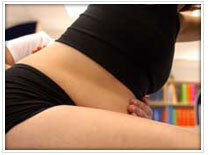OSTEOPATHY: Pregnancy
The postural changes that a woman’s body goes through during pregnancy are significant. Understandably, women are particularly aware of the workings of their body during this period. Osteopaths, for many years have applied  their knowledge of the anatomy and biomechanics to help alleviate the discomfort caused by weight gain and postural change during the pregnancy as well as after the pregnancy. their knowledge of the anatomy and biomechanics to help alleviate the discomfort caused by weight gain and postural change during the pregnancy as well as after the pregnancy.
Pregnancy, for many women is a time when they are forced to contend with a wide variety of ailments from sciatica to morning sickness. From one week to the next the mother experiences an increase in her weight and major postural changes, as the baby grows in the womb and as breast weight increases. If the body is not flexible enough to accommodate these changes the mother may start to feel aches and pains in her body.
Why osteopathy?
The safety of the baby and the mother are the primary concern of the osteopath. With this in mind, using gentle manual techniques, osteopathic treatment helps the  body to adapt to the changes occurring in the body. body to adapt to the changes occurring in the body.
Each pregnancy is unique; therefore osteopaths view the mother as an individual, taking account of the physical and emotional transition that she is experiencing. Treatment may be supplemented with self-help in the form of exercises and postural advice. With the help of osteopathic treatment some of the side-effects that accompany pregnancy such as indigestion, constipation, heartburn, back pain and sciatica can be relieved.
Useful tips
During pregnancy, due to the extra weight and the increased production of hormones such as relaxin (aids flexibility of pelvis during labour) the body is particularly vulnerable to stresses and strains. For this reason, a mother needs to take extra care of her body to avoid doing any damage.
- Alvoid combining movements, for example bending and twisting at the same time. Putting a child into their cot nearly always requires this movement and is a classic cause of disc-herniation.
- When lifting, make sure the object is close to the centre of your body, your back is straight and your arms are not extended. This reduces the effort recquired to lift and decreases the likelihood of doing any damage.
- Try to avoid carrying a child with one arm and resting its weight on your pelvis.
- When sitting in a soft chair make sure the low back is well supported with a cushion and avoid sitting in a chair with one leg crossed over the other.
- Take the time to adjust all the equipment that you may use such as pushchairs, changing-tables and prams so that it is comfortable for you and puts little strain on the back.
Visiting an osteopath
As with any visit to an osteopath, first your medical history will be recorded. Then the osteopath will ask you to remove some of your clothing so that an examination of the back, pelvis and limbs can be done.
Using his hands, the osteopath will employ a highly attuned sense of touch known as palpation, to identify areas of stress, strain, dysfunction and restriction in the body tissues. This will allow the osteopath to understand the workings of the body dynamically and tailor a treatment plan to suit your needs. The osteopath will try his utmost to make you feel comfortable, and any questions or concerns can be discussed. The osteopath may refer you back to your doctor or, with your permission, discuss the matter with another practitioner.
| 







